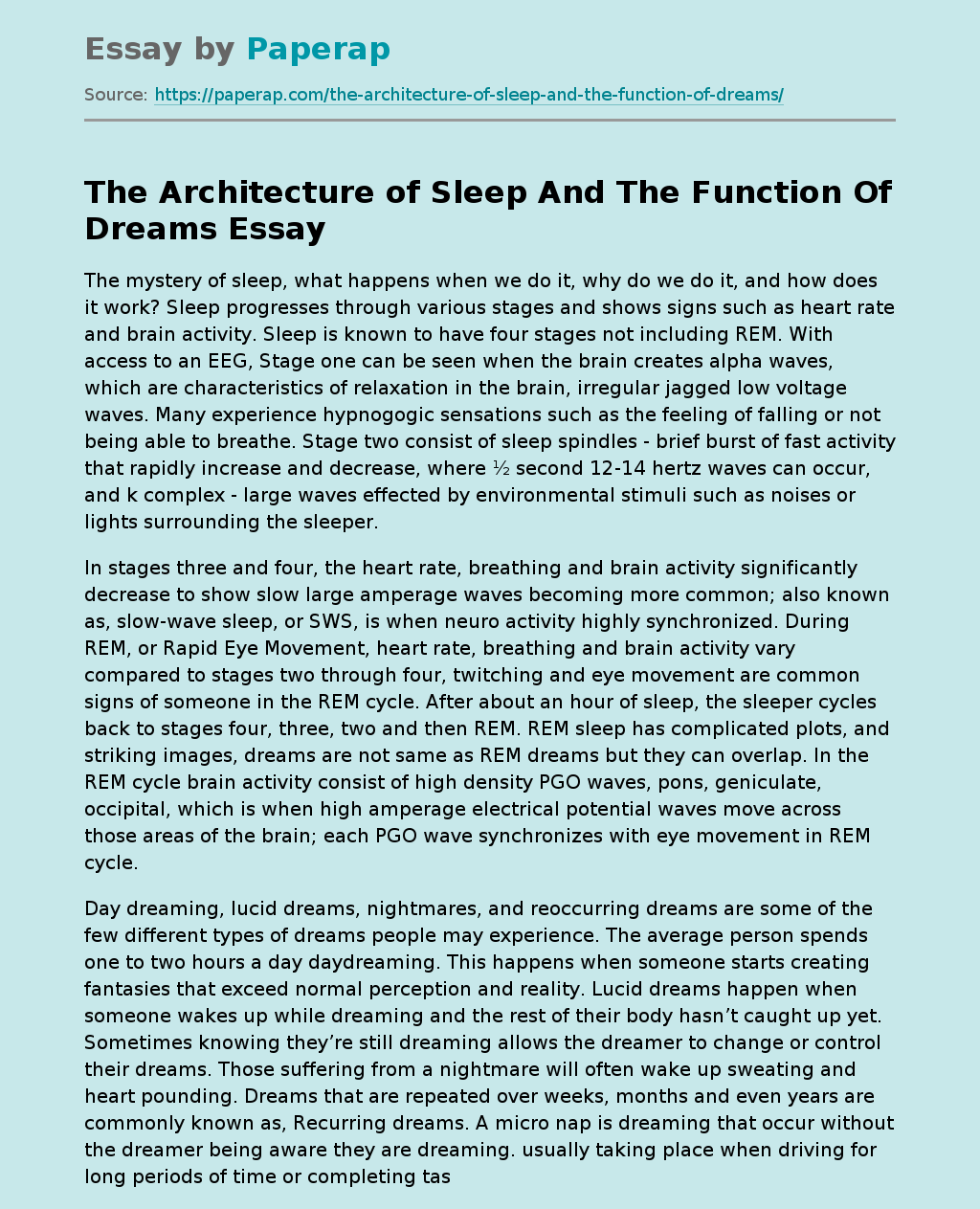The Architecture of Sleep And The Function Of Dreams
The mystery of sleep, what happens when we do it, why do we do it, and how does it work? Sleep progresses through various stages and shows signs such as heart rate and brain activity. Sleep is known to have four stages not including REM. With access to an EEG, Stage one can be seen when the brain creates alpha waves, which are characteristics of relaxation in the brain, irregular jagged low voltage waves. Many experience hypnogogic sensations such as the feeling of falling or not being able to breathe.
Stage two consist of sleep spindles – brief burst of fast activity that rapidly increase and decrease, where ½ second 12-14 hertz waves can occur, and k complex – large waves effected by environmental stimuli such as noises or lights surrounding the sleeper.
In stages three and four, the heart rate, breathing and brain activity significantly decrease to show slow large amperage waves becoming more common; also known as, slow-wave sleep, or SWS, is when neuro activity highly synchronized.
During REM, or Rapid Eye Movement, heart rate, breathing and brain activity vary compared to stages two through four, twitching and eye movement are common signs of someone in the REM cycle. After about an hour of sleep, the sleeper cycles back to stages four, three, two and then REM. REM sleep has complicated plots, and striking images, dreams are not same as REM dreams but they can overlap. In the REM cycle brain activity consist of high density PGO waves, pons, geniculate, occipital, which is when high amperage electrical potential waves move across those areas of the brain; each PGO wave synchronizes with eye movement in REM cycle.
Day dreaming, lucid dreams, nightmares, and reoccurring dreams are some of the few different types of dreams people may experience. The average person spends one to two hours a day daydreaming. This happens when someone starts creating fantasies that exceed normal perception and reality. Lucid dreams happen when someone wakes up while dreaming and the rest of their body hasn’t caught up yet. Sometimes knowing they’re still dreaming allows the dreamer to change or control their dreams. Those suffering from a nightmare will often wake up sweating and heart pounding. Dreams that are repeated over weeks, months and even years are commonly known as, Recurring dreams. A micro nap is dreaming that occur without the dreamer being aware they are dreaming. usually taking place when driving for long periods of time or completing task that have become like second nature to the dreamer. Different types of dreams effect everyone and we all experience them some remember them more than others.
German psychiatrist Sigmund Freud believed that dreams have a much deeper meaning. Freud thought he could help people increase their self-awareness and obtain valuable information to help them deal with problems they were faced in real life by analyzing their dreams. Freud distinguished the differences in manifest content and latent content of the dreams. The manifest content is the actual content or the act of a dream. Latent content refers to the hidden meaning of a dream. Dream theorists have offered several explanations to our dreams such as: satisfying our own desires, archiving memories, developing and maintaining neural pathways, making sense of neural static, and reflecting cognitive development. The truth is, we don’t know the purpose of dreams. “Ernest Hartmann, a professor of psychiatry at Tufts University School of Medicine and the director of the Sleep Disorders Center at Newton Wellesley Hospital in Boston, Mass., states, “Despite many theories, we still do not understand the purpose of sleep and we also do not know the functions of REM sleep (rapid eye movement), when most dreaming occurs.”
The Architecture of Sleep And The Function Of Dreams. (2021, Dec 14). Retrieved from https://paperap.com/the-architecture-of-sleep-and-the-function-of-dreams/

